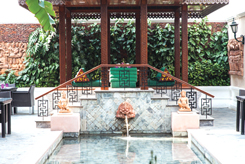
Embark on a culinary journey through Southeast Asia at The Spice Route
Proclaimed to be the only-oneof- its-kind restaurant, The Spice Route is poetry in design. The restaurant has been designed to reflect the journey of spices from the Malabar Coast in Kerala through Sri Lanka, Myanmar, Malaysia and Indonesia to Thailand and Vietnam.
It mesmerises all your senses, enrapturing you with its exotica. It offers a unique dining experience in a distinctively beautiful setting. The Spice Route Courtyard transports the guests to the wonderful world of Southeast Asia. Adorned with traditional Thai sculptures from the Chiang Mai region in northern Thailand, the Courtyard is a visual spectacle. A picture-perfect water-body with floating candles and thoughtfully strewn petals forms the centre of the Courtyard. The far end of the pavilion has traditional Khantok seating for six under an Oriental pagoda.
Designed to reflect the journey of spices from the Malabar Coast in Kerala through Sri Lanka, Myanmar, Malaysia and Indonesia to Thailand and Vietnam, the restaurant is a visual depiction of the art and culture that travelled with the spices through these regions. Designed by Rajeev Sethi, the celebrated cultural czar of India, The Spice Route took seven years in the making and is entirely hand-painted with vegetable and flower dyes, by mural painters brought in especially from a temple in Guruvayur in Kerala.
Designed on the principles of Feng Shui, this restaurant is divided into nine different sections, each a part of the journey of life. The Knowledge section at the entrance, for instance, has four 16th century pillars from a temple marking a narrow entrance. The next section signifies the three stages of life — artha, kama and moksha, that is, materialism, lust and the ultimate salvation. The next section is that of help and support and shows off an antique ceiling from Kerala, unique in the aspect that it lets the sunlight in, but not the rain.
The fourth section, closest to the kitchen, denotes creativity. This is followed by the relationship section demarcated by two-seaters and with antique beams in rosewood and Burma teak. The Fate and Fortune section with its “Wall of Fortune” is next, ensued by the Wealth section, embellished with 24-carat gold leafing on the wall and the ceiling, and is extremely popular for business lunches. The eighth section — the Ancestral, indicating the end of the journey of life — has replicas of the panels from various Thai temples. The courtyard in the middle of the Restaurant is the Food and Health section and blends the architectures of a Thai and Kerala home.
Besides the stunning décor, The Spice Route boasts a menu that caters to the taste buds of a seasoned food connoisseur. Orchestrated with passion by Chef Veena Arora, the menu stars gems such as Chemeen Thoren (Kerala style prawns, stir-fried with coconut, curry leaves and black tamarind; flavoured with mustard seeds), Tom Yum Kung (Famous Thai soup with prawns, flavoured with lemon grass, lemon leaves and galangal), Kung Nang Phad Khing (Stir-fried lobster with ginger and Thai black mushrooms, served in the shell), Kaeng Kheow Waan Kai (Chicken in Thai green curry with pea and cherry aubergines) and Phad Phak (Chef’s special stir-fried baby spinach with black mushrooms, flavoured with soya bean paste).
A non-smoking restaurant, the restaurant flows naturally into a strikingly pleasing courtyard that forms a backdrop for an extraordinary culinary fiesta during star-lit evenings and sunny, winter afternoons. The courtyard is bedecked with traditional Thai sculptures from Chiang Mai in northern Thailand. While one corner of the courtyard is done up with handmade bricks that are easily 100 years old, the far end entices guests to a khantok-style seating.
